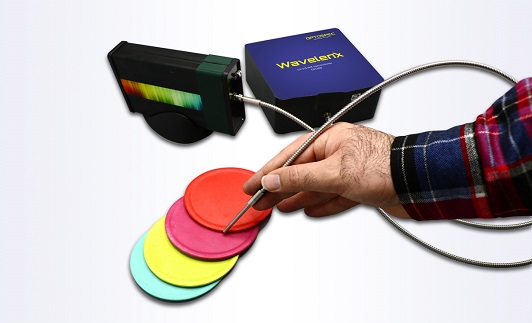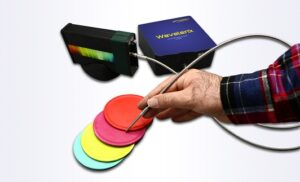Introduction
Spectrometry involves the measurement of the interaction between light and matter, as well as the quantification of the intensity and wavelength of light. It is important to note that spectroscopy and spectrometry are distinct from each other. A spectrometer is employed to determine the absorption, transmission, reflection, and analysis of light sources.
Absorption
We assume that electrons are connected to atoms through springs. Electrons and the attached springs oscillate at specific frequencies known as natural frequencies. When light with a certain frequency collides with an atom, the electrons in that atom become excited and vibrate. If a light wave with a frequency equal to the natural frequency interacts with a material, the electrons absorb the light’s energy and convert it into vibrational motion. During these vibrations, electrons interact with neighboring atoms in molecules, converting vibrational energy into thermal energy, resulting in absorption. Since atoms and molecules have different natural frequencies, they selectively absorb different frequencies of light.
On the other hand, when an electromagnetic wave interacts with a molecule, it gets absorbed depending on the wavelength of the radiation and the molecular structure. In other words, electrons within that molecule get excited and absorb energy, transitioning to higher molecular energy states. Since all materials contain electrons, a portion of visible and ultraviolet light will be absorbed by molecules in any case. In this type of spectroscopy, as shown in Figure 1, the outgoing rays from the light source, after passing through the sample, enter the spectrometer, and the absorption spectrum of the sample is obtained. The absorption spectrum is used to determine concentration, molecular analysis, process control, structural studies, and fundamental research.

The amount of photons that pass through the cuvette and reach the detector depends on the cuvette’s length and the sample’s concentration. When light passes through the cuvette, a portion of it is absorbed, and the rest passes through. The amount of light transmitted through the sample (T) can be determined using the following equations:
T (Transmittance) = It / I0
T is the intensity of light passing through the cuvette, and I0 is the intensity of the light source. The amount of light absorbed can be easily calculated from the following equation:
A (Absorbance) = – log (T) = – log (It / I0)
The term “absorption” refers to the amount of photons absorbed by the sample. With the knowledge of the absorption value, the concentration of the sample can be determined using the Beer-Lambert law. This law states that there is a linear relationship between absorption and the sample’s concentration, as follows:
A = ɛlc
In this formula, A represents absorption, ε represents the molar absorptivity (also known as the molar absorption coefficient), l represents the path length of the sample, and c represents the concentration of the sample. To determine the concentration of an unknown sample, samples of different known concentrations are prepared from the same sample, and their absorbance values (both for the unknown sample and the other samples) are measured at a specific wavelength. By plotting a linear concentration-absorbance graph (Figure 1), the concentration of the unknown sample can be determined.

Reflection and Transmission
The reflection and transmission of light waves occur because the frequencies of the light waves do not match the natural oscillation frequencies of the atoms in the material. When light waves collide with a material, the electrons in the atoms begin to vibrate. However, instead of vibrating with a large amplitude, the electrons briefly oscillate with small amplitudes. The energy is then reflected in the form of light waves. Figure 2 shows the arrangement of the Wavelenx spectrometer for obtaining the amount of reflection and transmission. The outgoing beam from the light source interacts with the solution. Then, by using a reflective (transmissive) probe, the reflected light (transmitted) from the sample is directed towards the spectrometer, resulting in the reflection or transmission spectrum. Figure 2 displays an example of a transmission spectrum from a color filter. Reflectance and transmittance spectra are used for non-destructive testing of surfaces and thin films, quality control of pharmaceutical products, quantitative measurements of various components in food materials, identification and classification of polymer types, detection of pharmaceutical compounds, portable diagnostic equipment for glucose and blood flow, determining the fat and protein content in meat, and more.


Emission Spectroscopy
A spectrometer can also be used for analyzing light sources (Figure 3). A light source is connected to the spectrometer using optical fibers. Figure 3 shows the spectrum of a mercury lamp. A spectrometer is used for measuring the radiant power of lamps and LEDs, determining the wavelength and stability of laser centers, measuring the intensity of radiant flux, controlling the timing of intensity in the UV/VIS/NIR wavelength range with high sensitivity, and so on.


Fluorescence
The phenomenon of fluorescence refers to a type of luminescence. In general, luminescence is the emission of light from a molecule. Both fluorescence and phosphorescence involve a substance’s ability to absorb light and emit light at longer wavelengths and, consequently, lower energy. In both phenomena, when a substance is exposed to light (primarily ultraviolet), it becomes excited, storing this energy within itself, and then releases that energy in the form of a spectrum of visible waves over a period of time. The main difference between fluorescence and phosphorescence lies in the duration of their emission. If the excited state lasts less than 8-10 seconds, it is called fluorescence. On the other hand, if the excited state persists for more than 8-10 seconds, it is referred to as phosphorescence. In other words, phosphorescence has a longer-lasting excitation and, consequently, will emit longer-wavelength radiation. It continues for a period of time even after the light source is removed. The duration of phosphorescence can vary from seconds to hours, depending on the substance. However, in the case of fluorescence, it is an instantaneous emission, and the radiation stops immediately after turning off the light source. In fluorescence, an electron is excited by absorbing energy, and it releases some of its energy in the form of heat (phonon) and the rest of its energy in the form of a photon from the singlet state. The wavelength of fluorescent light is longer than the excitation wavelength, and this phenomenon is referred to as the Stokes shift.
Excitation: S0 + h?ex → S1
Fluorescence (emission) : S1 → h?em + S0 + Phonons

Using spectrometry, the amount of material fluorescence can be measured. Since fluorescent light is emitted in all directions, the optical fiber is positioned at a 90-degree angle to the incident beam. This minimizes the probability of transmitted and reflected light reaching the detector. Fluorescence spectrometry is used for environmental applications (measurement of solution pH), biology (chlorophyll II and carotenoids), studying the fluorescence spectrum of nanoparticles, and more.
Summary
Spectrometry is a method where the interaction of light with the substance under investigation is studied. Absorption, transmission, reflection, and fluorescence are some of the interactions that, by obtaining their spectra, provide information about parameters such as the concentration and structure of materials, drug compositions, the fat and protein content in meat, the pH of solutions, and more. Additionally, spectrometry can be used to determine the spectral characteristics of light sources and extract some of their properties.



